Is Bitcoin bad for the environment? This question sparks heated debates among environmentalists and Bitcoin enthusiasts alike. With Bitcoin’s energy consumption rivaling some countries’, it’s crucial to dissect its environmental footprint. This article dives into the heart of the matter, exploring the ecological impacts of Bitcoin mining and highlighting both its challenges and strides toward sustainability. We’ll tackle the controversies, innovations, and potential pathways forward, offering insights that matter to eco-conscious investors and policymakers alike.
A Brief Overview of Bitcoin
Bitcoin, a revolutionary digital currency, emerged from the ashes of the 2008 financial crisis. Satoshi Nakamoto, its pseudonymous creator, aimed to create a currency free from central bank control. This alternative to traditional banking systems empowers users with peer-to-peer transactions.
This autonomy is achieved through a technology called blockchain, a public ledger that records all Bitcoin transactions.
However, as Bitcoin’s price and popularity soared, so did scrutiny over its climate impact.
The process of Bitcoin mining, essential for transaction verification and coin generation, requires substantial computational power. And it consumes vast amounts of electricity, leading to growing concerns about the sustainability of the network and its carbon footprint.
Bitcoin’s environmental impact has become a pivotal issue. As we delve deeper into Bitcoin’s journey, we will weigh its pioneering benefits against its environmental costs.
How Bitcoin Mining Works
Bitcoin mining is the heartbeat of the Bitcoin network. It’s a complex process where miners use powerful computers to participate in a sort of lottery. Each winning ticket allows a miner to add a new block of transactions to the blockchain.

This not only verifies and secures transactions, but also releases new Bitcoins into circulation as a reward to the successful miners. This incentive ensures the network remains secure and operational.
The catch? This mining process demands an enormous amount of computational power. The lottery is designed to be difficult. As more miners join the rounds, it becomes increasingly challenging to keep the rate of new Bitcoin creation steady.
This competition drives the continuous operation of high-powered computer systems, which, in turn, drives up electricity consumption.
Interested in joining the mining community? Begin with our guide on starting BTC mining for free.
As the value of Bitcoin rises, so does the incentive to mine, further escalating the network’s electricity usage. This cycle is at the core of the debate over Bitcoin’s impact on the climate.
The Environmental Impact of Bitcoin
Bitcoin’s energy consumption is often criticized, yet it uses only 0.17% of global energy and emits 0.11% of CO2, as per the BMC Q4 2022 report.
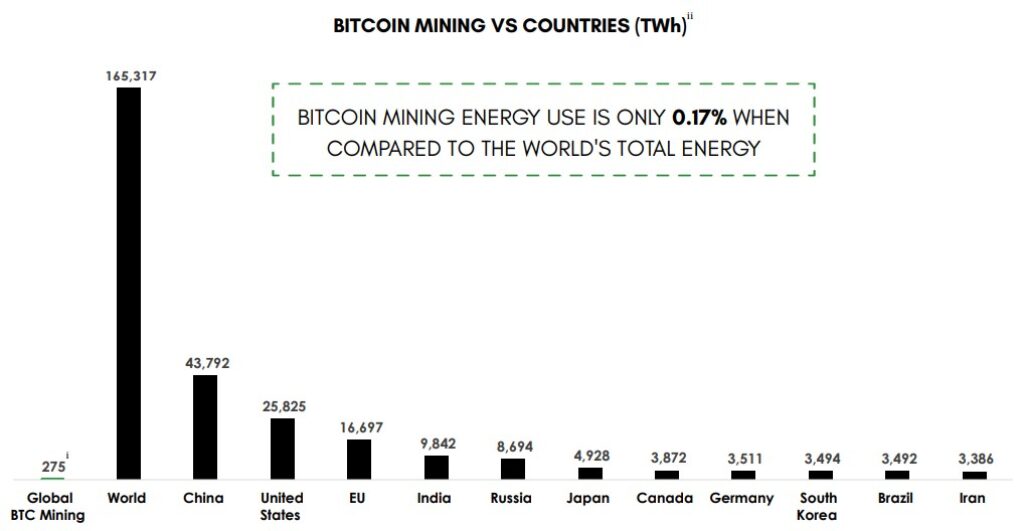
Remarkably, 58.9% of this energy comes from sustainable sources, outpacing the green energy use in all countries.
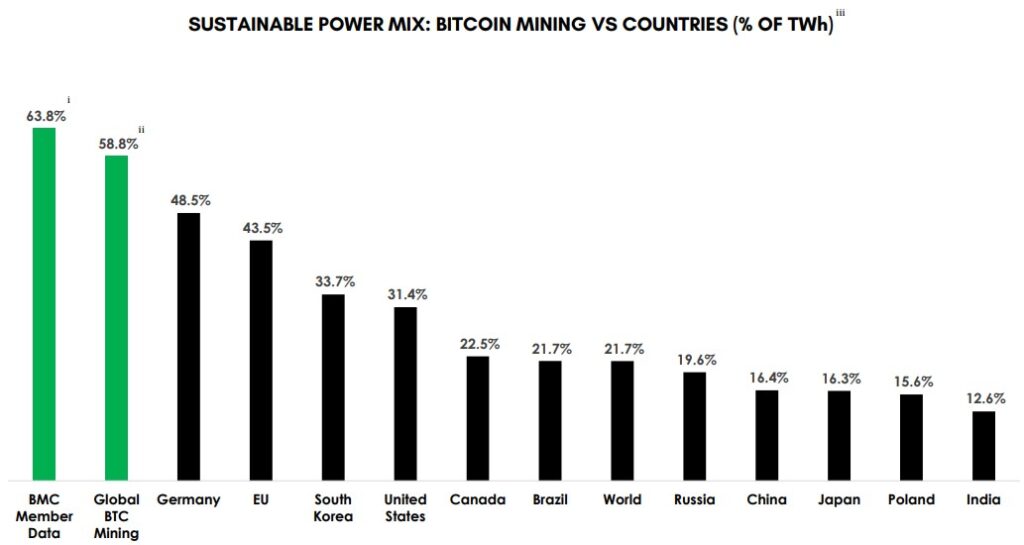
Furthermore, Bitcoin mining’s efficiency has improved by 16% year-over-year, with significant advancements in security and sustainability expected to continue.
A KPMG study offers a new perspective on Bitcoin’s emissions, highlighting a relative environmental impact in a broader industrial context. Its carbon emissions are notably lower than the emissions from gold mining, and significantly less than the fashion industry’s.
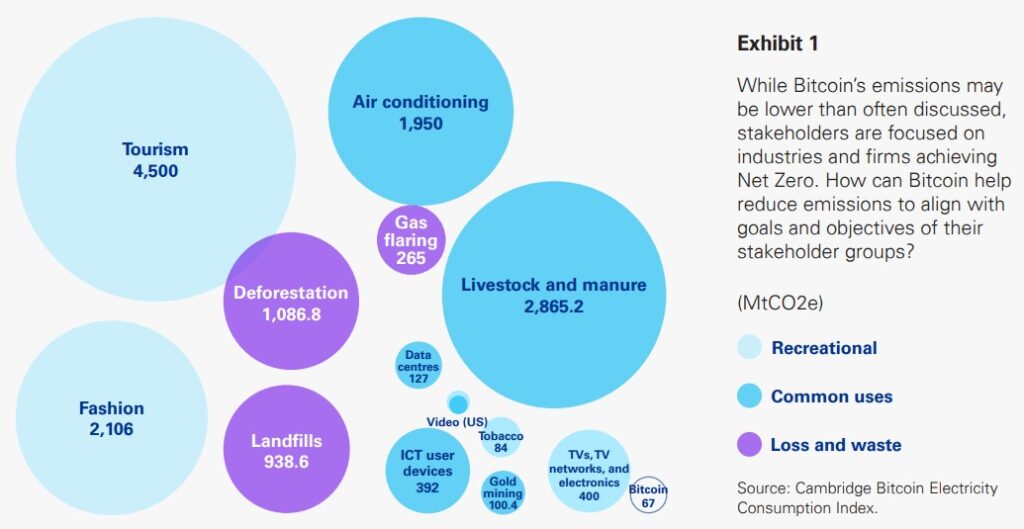
The BEEST (Bitcoin Energy and Emissions Sustainability Tracker), a second methodology, estimates that 52.6% of Bitcoin mining uses zero-emission energy sources. This finding includes data on off-grid mining, providing a more comprehensive view of the network’s energy mix.
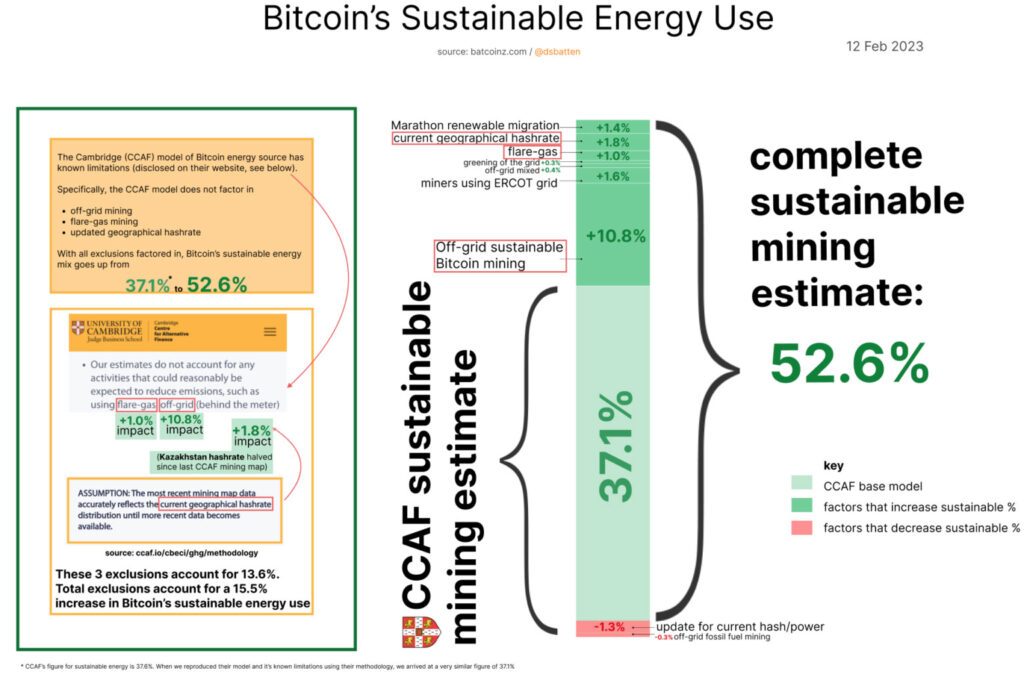
This contrasts with the banking sector’s energy usage.
Indeed, a research article on energy mixes shows the financial industry has a sustainable energy usage of 39.2% and an emission intensity of 464g/kWh. In comparison, Bitcoin’s operations are more efficient, with a lower emission intensity of 296g/kWh.
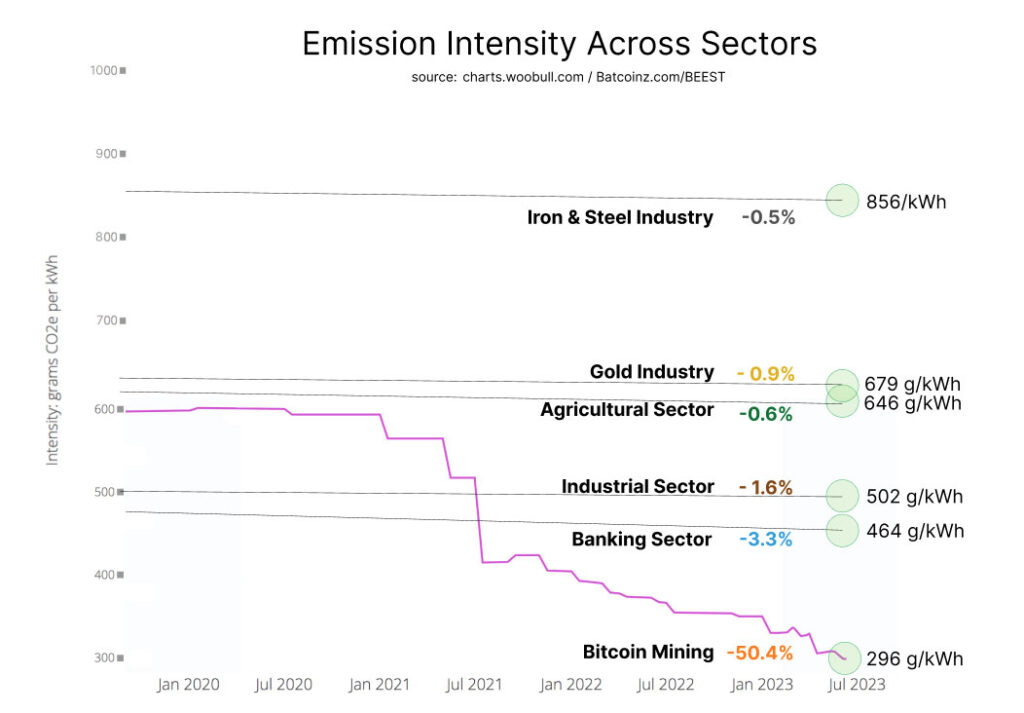
This comparison highlights Bitcoin’s strides towards sustainability, challenging conventional views about its climate impact compared to traditional financial systems.
Efforts to Reduce the Impact
As we pivot to the next section, we’ll explore the proactive measures being taken within the Bitcoin community to address environmental concerns.
Improvement in Miner Efficiency
The Bitcoin mining landscape is witnessing a significant evolution with the introduction of more energy-efficient hardware technologies. These advancements mean that mining rigs can now generate more hashes per watt of electricity consumed.
Bitcoin mining is technology intensive, increasing 58x in efficiency over 8 years.
Bitcoin Mining Council, Q4 2022 report
This shift not only enhances the profitability of mining activities, but also plays a crucial role in reducing the overall energy consumption of the Bitcoin network.
Network Incentives for Cheap and Renewable Energy Sources
The Bitcoin mining industry is increasingly incentivized to seek out cheaper and more sustainable sources due to the cost dynamics of mining rewards.
This economic motivation drives mining companies towards renewable sources such as solar, wind, hydro, and geothermal.
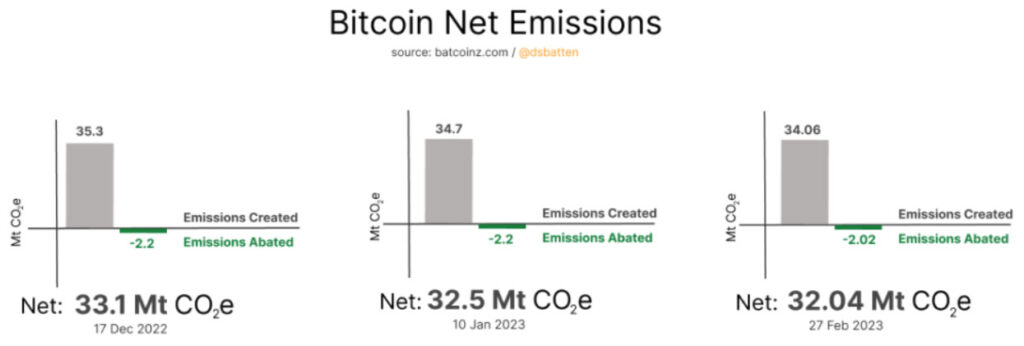
Utilizing these sources not only reduces operational costs, but also enhances profitability, making renewable energy a compelling option for mining farms.
The shift towards green energy is not just an environmental choice but a strategic financial decision. And it highlights the synergy between economic benefits and sustainability in the Bitcoin mining ecosystem.
Utilization of Stranded Energy and Reduction of Waste
Bitcoin mining is innovatively tapping into stranded energy, utilizing excess renewable energy that would otherwise go unused.
This approach includes harnessing surplus power from hydroelectric, geothermal, and biomass sources, strategically placing mining operations near these abundant resources.
By converting what would be wasted energy into a valuable asset, Bitcoin mining not only optimizes consumption, but also significantly lowers its environmental impact. This method showcases a practical application of renewable energy, reducing waste and contributing to the sustainability of the Bitcoin network.
Gridless, a company operating in East Africa, stands out in this innovative approach. It collaborates with renewable, rural, mini-grid energy generators, turning excess energy into a productive asset through Bitcoin mining.
Grid Decarbonization through Demand Response and Incentivizing Renewables
Bitcoin mining can significantly support grid decarbonization through demand response programs. By acting as a flexible load, miners can reduce energy consumption during peak demand times, alleviating stress on the grid.
This adaptability not only stabilizes the grid, but also encourages the use of renewable sources of energy.
For example, Riot demonstrated this approach by providing power back to the Texas grid during a heat wave, earning revenue through ERCOT’s ancillary services program, which incentivizes such energy-saving measures.
Methane Mitigation through Capture and Combustion
Bitcoin mining is innovatively contributing to methane mitigation by capturing flared gas from oil extraction and landfill gas, which would otherwise be released into the atmosphere.
Companies like Upstream Data and Vespene Energy have developed technologies that allow for the conversion of methane, a potent greenhouse gas, into electricity for Bitcoin mining. This process not only reduces greenhouse gas emissions, but also turns an environmental liability into an economic asset, demonstrating a profitable use for what would otherwise be a waste product.
The practice underscores a broader trend within the Bitcoin mining industry towards sustainability and environmental responsibility. By utilizing flared or vented methane emissions, Bitcoin miners can generate energy for their operations in a manner that is both economically and environmentally beneficial.
This approach not only captures and uses methane that would have contributed to global warming, but also supports the oil and gas industry in achieving more sustainable practices.
Frequently Asked Questions
Bitcoin’s current estimated annual energy consumption is around 170.37 TWh, according to the Cambridge Bitcoin Electricity Consumption Index (CBECI).
Bitcoin miners themselves do not directly emit CO2, as demonstrated by Pierre Rochard from Riot. However, the electricity used for mining, if generated from fossil fuels, contributes to carbon emissions.
Assessing Bitcoin’s energy use involves more than just consumption figures; it’s about the value and innovation the digital gold brings. Critics argue it consumes too much power, often comparing it unfavorably to countries’ energy usage. However, supporters highlight its benefits, like financial inclusivity and security. Moreover, Bitcoin incentivizes renewable energy investments and utilizes energy that would otherwise be wasted.
Bitcoin can become more environmentally friendly by increasing the use of renewable energy sources for mining operations, improving energy efficiency with advanced mining hardware, and leveraging off-grid solutions like flared gas capture. Additionally, supporting carbon offset initiatives and incentivizing green practices within the community can contribute to a more sustainable ecosystem. These measures not only reduce the carbon footprint but also enhance the overall efficiency of Bitcoin mining, aligning it with broader environmental goals.
Modifying Bitcoin’s code to change its consensus mechanism, such as shifting from Proof of Work (PoW) to Proof of Stake (PoS), would create a fundamentally different system. This new system would not automatically inherit Bitcoin’s network, users, or value, as stakeholders’ consensus is crucial for such a transition.
No, there are no credible alternatives to Bitcoin to separate money and state. Alternatives to Bitcoin that use PoS, like Ethereum, have not demonstrated the same level of security and decentralization. learn more about PoS and PoW on River.
Conclusion
In wrapping up, it’s vital to juxtapose Bitcoin’s environmental footprint with its benefits.
Is Bitcoin bad for the environment?
Despite energy concerns, Bitcoin incentivizes renewable energy use and leverages wasted energy sources, presenting a path toward a more sustainable future.
Its decentralized nature and security, powered by Proof of Work, offer unparalleled benefits that, for many, outweigh the environmental costs.
For a deeper understanding of how Bitcoin contributes positively to environmental efforts, explore this insightful podcast from Bitcoin Magazine: Bitcoin Is a Net Benefit to the Environment. It invites a nuanced view of Bitcoin’s ecological impact, encouraging a balanced assessment of its global contributions.
Ready to embrace Bitcoin’s potential? Start by setting up your first BTC wallet with our easy guide.
